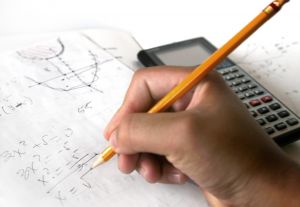To develop an approximate \((1-\alpha)100\%\) confidence interval for \(\rho\), we'll use the normal approximation for the statistic \(Z\) that we used on the previous page for testing \(H_0:\rho=\rho_0\).
Theorem
An approximate \((1-\alpha)100\%\) confidence interval for \(\rho\) is \(L\leq \rho \leq U\) where:
\(L=\dfrac{1+R-(1-R)\text{exp}(2z_{\alpha/2}/\sqrt{n-3})}{1+R+(1-R)\text{exp}(2z_{\alpha/2}/\sqrt{n-3})}\)
and
\(U=\dfrac{1+R-(1-R)\text{exp}(-2z_{\alpha/2}/\sqrt{n-3})}{1+R+(1-R)\text{exp}(-2z_{\alpha/2}/\sqrt{n-3})}\)
Proof
We previously learned that:
\(Z=\dfrac{\dfrac{1}{2}ln\dfrac{1+R}{1-R}-\dfrac{1}{2}ln\dfrac{1+\rho}{1-\rho}}{\sqrt{\dfrac{1}{n-3}}}\)
follows at least approximately a standard normal \(N(0,1)\) distribution. So, we can do our usual trick of starting with a probability statement:
\(P\left(-z_{\alpha/2} \leq \dfrac{\dfrac{1}{2}ln\dfrac{1+R}{1-R}-\dfrac{1}{2}ln\dfrac{1+\rho}{1-\rho}}{\sqrt{\dfrac{1}{n-3}}} \leq z_{\alpha/2} \right)\approx 1-\alpha\)
and manipulating the quantity inside the parentheses:
\(-z_{\alpha/2} \leq \dfrac{\dfrac{1}{2}ln\dfrac{1+R}{1-R}-\dfrac{1}{2}ln\dfrac{1+\rho}{1-\rho}}{\sqrt{\dfrac{1}{n-3}}} \leq z_{\alpha/2}\)
to get ..... can you fill in the details?! ..... the formula for a \((1-\alpha)100\%\) confidence interval for \(\rho\):
\(L\leq \rho \leq U\)
where:
\(L=\dfrac{1+R-(1-R)\text{exp}(2z_{\alpha/2}/\sqrt{n-3})}{1+R+(1-R)\text{exp}(2z_{\alpha/2}/\sqrt{n-3})}\) and \(U=\dfrac{1+R-(1-R)\text{exp}(-2z_{\alpha/2}/\sqrt{n-3})}{1+R+(1-R)\text{exp}(-2z_{\alpha/2}/\sqrt{n-3})}\)
as was to be proved!
Example 15-2 (Continued) Section

An admissions counselor at a large public university was interested in learning whether freshmen calculus grades are independent of high school math achievement test scores. The sample correlation coefficient between the mathematics achievement test scores and calculus grades for a random sample of \(n=10\) college freshmen was deemed to be 0.84.
Estimate the population correlation coefficient \(\rho\) with 95% confidence.
Answer
Because we are interested in a 95% confidence interval, we use \(z_{0.025}=1.96\). Therefore, the lower limit of an approximate 95% confidence interval for \(\rho\) is:
\(L=\dfrac{1+0.84-(1-0.84)\text{exp}(2(1.96)/\sqrt{10-3})}{1+0.84+(1-0.84)\text{exp}(2(1.96)/\sqrt{10-3})}=0.447\)
and the upper limit of an approximate 95% confidence interval for \(\rho\) is:
\(U=\dfrac{1+0.84-(1-0.84)\text{exp}(-2(1.96)/\sqrt{10-3})}{1+0.84+(1-0.84)\text{exp}(-2(1.96)/\sqrt{10-3})}=0.961\)
We can be (approximately) 95% confident that the correlation between the population of high school mathematics achievement test scores and freshmen calculus grades is between 0.447 and 0.961. (Not a particularly useful interval, I might say! It might behoove the admissions counselor to collect data on a larger sample, so that he or she can obtain a narrower confidence interval.)